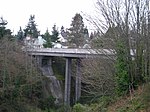Camp 6 Logging Museum
Defunct museums in Washington (state)Forestry museums in the United StatesIndustry museums in Washington (state)Museums in Tacoma, WashingtonPoint Defiance ... and 1 more
Railroad museums in Washington (state)

Camp 6 Logging Museum was located on a 14-acre (57,000 m2) forested site inside Point Defiance Park in Tacoma, Washington. Established in 1964 as the Camp Six Logging Exhibit by Western Forest Industries Museum, Inc by members of the Logging Industry in Washington State. Designed by logging engineers, Camp 6 included a replica of an operating railroad connecting the working sites with the bunk houses and bunk cars of the camp.The museum was a National Registered Historic Place, and featured several historic buildings and over 500 tons railroad and logging equipment. Many pieces of equipment were powered by steam.
Excerpt from the Wikipedia article Camp 6 Logging Museum (License: CC BY-SA 3.0, Authors, Images).Camp 6 Logging Museum
Five Mile Drive, Tacoma
Geographical coordinates (GPS) Address Website Nearby Places Show on map
Geographical coordinates (GPS)
| Latitude | Longitude |
|---|---|
| N 47.3033 ° | E -122.5277 ° |
Address
SAMI
Five Mile Drive
98407 Tacoma
Washington, United States
Open on Google Maps









